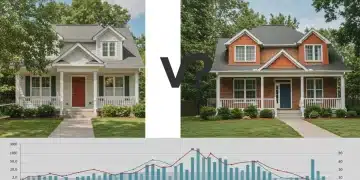Mortgage Forbearance Options 2025: Federal Relief Up to 12 Months

Federal mortgage forbearance options for 2025 provide homeowners with critical payment relief for up to 12 months, offering a lifeline amidst financial challenges and ensuring housing stability.
As 2025 unfolds, homeowners facing financial distress are keenly watching developments regarding Mortgage Forbearance Options 2025: Navigating Federal Programs for Up to 12 Months of Relief. These programs are designed to provide a vital safety net, allowing individuals to temporarily reduce or pause mortgage payments during challenging times.
Understanding Mortgage Forbearance in 2025
Mortgage forbearance is not debt forgiveness, but rather a temporary postponement or reduction of mortgage payments. This critical relief mechanism allows homeowners to stabilize their finances during periods of unexpected hardship. As of early 2025, federal programs continue to offer structured support, primarily through government-backed loans and agency guidelines.
The landscape of forbearance programs is shaped by ongoing economic conditions and legislative updates. Homeowners need to understand that while forbearance offers immediate relief, the deferred payments will eventually need to be repaid. The terms and conditions for repayment vary significantly depending on the specific program and lender.
What is Forbearance?
- Temporary Relief: Allows a temporary pause or reduction in mortgage payments.
- Not Forgiveness: Deferred payments must be repaid later, often through a repayment plan, loan modification, or deferral.
- Eligibility Criteria: Typically requires demonstrated financial hardship, such as job loss, illness, or significant income reduction.
- Impact on Credit: Generally, forbearance during a declared hardship does not negatively impact credit scores if managed correctly.
The primary goal of these programs is to prevent foreclosures and keep families in their homes. Forbearance acts as a bridge, giving homeowners time to recover financially without the immediate pressure of full mortgage payments. This support is particularly crucial for those navigating unforeseen economic shifts or personal crises.
Key Federal Forbearance Programs for 2025
Several federal agencies oversee mortgage forbearance programs, primarily for loans they guarantee or purchase. These include Fannie Mae, Freddie Mac, FHA, VA, and USDA loans. Each agency has its own set of guidelines, but they generally align on the core principle of providing temporary relief to struggling homeowners.
For 2025, the emphasis remains on flexibility and homeowner support. While the broad frameworks are in place, specific details regarding application deadlines and maximum forbearance periods can evolve. Homeowners must stay informed about the latest announcements from their loan servicers and relevant federal agencies.
Fannie Mae and Freddie Mac Guidelines
Loans backed by Fannie Mae and Freddie Mac represent a significant portion of the U.S. mortgage market. Both entities have established guidelines for servicers to offer forbearance to eligible borrowers experiencing hardship. These guidelines often provide for initial forbearance periods, with options for extensions up to a cumulative maximum.
- Initial Forbearance: Typically 3 to 6 months, renewable based on continued hardship.
- Maximum Duration: Can extend up to 12 months, and in some cases, even longer depending on specific circumstances and program updates.
- Repayment Options: Include repayment plans, deferral options, and loan modifications.
It is important for homeowners with Fannie Mae or Freddie Mac loans to contact their mortgage servicer directly to discuss their options and initiate the application process. Servicers are mandated to work with borrowers to find suitable solutions.
Eligibility Criteria and Application Process
Accessing mortgage forbearance requires meeting specific eligibility criteria, which primarily revolve around demonstrating financial hardship. While the exact requirements can vary slightly between programs, common themes include a significant reduction in income, job loss, illness, or other unexpected life events that impact one’s ability to make mortgage payments.
The application process typically begins with contacting your mortgage servicer. It is crucial to act promptly once you anticipate or experience financial difficulties. Delaying communication can limit available options and potentially lead to more severe consequences.
Steps to Apply for Forbearance
- Contact Your Servicer: This is the first and most critical step. Inform them of your financial hardship and inquire about forbearance options.
- Provide Documentation: Be prepared to submit documentation proving your financial hardship, such as pay stubs, bank statements, or a letter explaining your situation.
- Understand the Terms: Carefully review the forbearance agreement, including the duration, repayment options, and any potential fees.
- Follow Up: Maintain regular communication with your servicer throughout the forbearance period.

Timely communication and thorough documentation are key to a successful forbearance application. Servicers are generally willing to work with homeowners who are proactive and transparent about their financial struggles.
Up to 12 Months of Relief: What to Expect
Many federal forbearance programs in 2025 offer the possibility of up to 12 months of payment relief. This extended period is designed to provide substantial breathing room for homeowners to regain financial stability. However, it is not an automatic entitlement and often involves an initial period followed by extensions based on continued need.
Homeowners should understand that the 12-month period is a cumulative maximum for many programs, not necessarily a continuous block of relief. The initial forbearance period might be shorter, with extensions granted upon re-evaluation of the homeowner’s circumstances. This structure ensures that relief is provided as long as it is genuinely needed.
Managing the Forbearance Period
- Budgeting: Use the relief period to reassess and adjust your household budget, prioritizing essential expenses.
- Seeking Assistance: Explore additional financial assistance programs or credit counseling if needed.
- Planning for Repayment: Begin strategizing how you will manage the deferred payments once the forbearance period ends.
During the forbearance period, it is essential to monitor your financial situation closely and communicate any changes to your servicer. Proactive management of this period will significantly impact your post-forbearance success.
Post-Forbearance Repayment Options
The end of a forbearance period marks a critical juncture for homeowners. It is at this point that the deferred payments become due. Federal programs and servicers offer several options to manage these accumulated payments, aiming to avoid a lump-sum repayment that could be financially devastating for many.
Understanding these repayment strategies before entering forbearance is crucial for effective financial planning. Homeowners should discuss these options with their servicer early in the process to determine the best path forward based on their anticipated financial recovery.
Common Repayment Strategies
Upon the conclusion of forbearance, homeowners typically have access to multiple repayment solutions. These are designed to integrate the deferred payments back into their financial plan without causing undue hardship. The most common options include:
- Repayment Plan: The homeowner makes their regular mortgage payment plus an additional amount each month to cover the deferred payments over a set period.
- Payment Deferral (or Partial Claim): The deferred payments are added to the end of the loan term, becoming due when the home is sold or refinanced. This option maintains the current monthly payment.
- Loan Modification: The original loan terms are permanently changed, potentially altering the interest rate, extending the loan term, or adding the deferred payments to the principal balance. This can result in a new, more affordable monthly payment.
- Reinstatement: The homeowner pays back the entire deferred amount in a single lump sum. This is often the least feasible option for those who experienced significant hardship.
The choice of repayment option depends heavily on the homeowner’s financial situation at the time forbearance ends. Loan servicers are generally required to work with borrowers to identify the most suitable and sustainable solution.
Protecting Your Home: Avoiding Foreclosure
The ultimate goal of mortgage forbearance programs is to prevent foreclosure. By providing temporary relief, homeowners are given an opportunity to recover financially and avoid losing their homes. However, it is imperative that homeowners understand their responsibilities and options to effectively leverage forbearance as a foreclosure prevention tool.
Ignoring the problem or failing to communicate with your servicer can lead to dire consequences. Foreclosure is a complex and lengthy process, but it can be initiated if a homeowner defaults on their mortgage, even after a forbearance period, if no repayment plan is established.
Critical Steps to Avoid Foreclosure
To effectively protect your home, several proactive steps are essential. These actions can significantly improve your chances of navigating financial hardship successfully and avoiding foreclosure.
- Proactive Communication: Always maintain open lines of communication with your mortgage servicer. Do not wait until you are behind on payments to reach out.
- Understand Your Options: Be knowledgeable about all available forbearance and repayment options. Don’t hesitate to ask questions.
- Seek Counseling: Consider contacting a HUD-approved housing counselor. These professionals can provide free or low-cost advice on managing mortgage issues and navigating forbearance.
- Review All Documents: Before signing any agreement, thoroughly read and understand all terms and conditions related to your forbearance or repayment plan.
By taking these steps, homeowners can empower themselves to make informed decisions and work collaboratively with their servicers to protect their most valuable asset.
Resources and Support for Homeowners
Navigating the complexities of mortgage forbearance can be daunting, but numerous resources are available to support homeowners. Federal agencies, non-profit organizations, and housing counselors offer guidance, information, and direct assistance to those in need.
These resources are designed to help homeowners understand their rights, explore their options, and make informed decisions about their mortgage. Utilizing these support systems can significantly ease the burden of financial hardship and improve outcomes.
Where to Find Help
Accessing reliable information and expert advice is crucial for homeowners considering or currently in forbearance. Several key entities provide valuable support:
- HUD-Approved Housing Counseling Agencies: These agencies offer free or low-cost counseling services, helping homeowners understand their options, prepare documentation, and negotiate with servicers. The HUD website provides a search tool to find local counselors.
- Consumer Financial Protection Bureau (CFPB): The CFPB offers extensive resources, guides, and tools for homeowners dealing with mortgage issues. Their website is a valuable source of unbiased information.
- Federal Housing Finance Agency (FHFA): For loans backed by Fannie Mae and Freddie Mac, the FHFA provides oversight and publishes guidelines for servicers. Their announcements are important for understanding program specifics.
- Your Mortgage Servicer: While they are the counterparty in your loan, servicers are also required to provide information and guidance on forbearance options. It’s crucial to engage with them directly.
Leveraging these resources can provide homeowners with the confidence and knowledge needed to effectively manage their mortgage during challenging times, ensuring they make the best decisions for their financial future.
| Key Point | Brief Description |
|---|---|
| Forbearance Definition | Temporary pause or reduction of mortgage payments due to financial hardship, not debt forgiveness. |
| Federal Programs 2025 | Fannie Mae, Freddie Mac, FHA, VA, and USDA loans offer up to 12 months of relief. |
| Application Process | Contact servicer, demonstrate hardship, provide documentation, and understand terms. |
| Repayment Options | Plans include repayment, deferral, or loan modification; lump-sum reinstatement is less common. |
Frequently Asked Questions About Mortgage Forbearance
Federal mortgage forbearance programs in 2025 typically allow for up to 12 months of payment relief. This period often involves an initial forbearance term followed by extensions, contingent on the homeowner’s continued demonstration of financial hardship and compliance with servicer requirements.
For federal loans during a declared hardship, forbearance generally does not negatively impact your credit score, provided your account was current before the forbearance and you adhere to the agreement. It’s crucial to confirm this with your servicer and monitor your credit report.
Skipped payments during forbearance are not forgiven; they are deferred. At the end of the forbearance period, these payments must be repaid. Options include a repayment plan, a deferral (adding them to the end of the loan), or a loan modification, depending on your servicer and program.
Eligibility for federal mortgage forbearance in 2025 primarily requires demonstrating financial hardship, such as job loss, significant income reduction, or other unexpected events affecting your ability to make payments. The loan must typically be backed by a federal agency like Fannie Mae, Freddie Mac, FHA, VA, or USDA.
Yes, it is highly recommended to contact your mortgage servicer as soon as you anticipate financial hardship. Proactive communication can open up more options and allow you to establish a forbearance plan before you fall behind on payments, preventing potential negative consequences.
What Happens Next
As 2025 progresses, the ongoing availability and specific terms of federal mortgage forbearance programs will remain a critical focus for homeowners and policymakers alike. The economic landscape continues to evolve, making these flexible relief options essential. Homeowners experiencing or anticipating financial difficulties should prioritize immediate engagement with their mortgage servicers and leverage available resources. Staying informed about legislative updates and agency guidelines will be paramount in navigating these programs effectively and securing long-term housing stability. The emphasis will likely remain on preventing foreclosures and providing structured pathways to financial recovery for struggling households.





